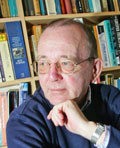Like most real-world disciplines, with the exception of best practice in medical research, it is rarely that those of us in education get to witness anything resembling a controlled experiment. In this case, all I mean by that is a situation in which just one variable changes between two teaching situations, so that we are privileged to get a clue about the significance of that variable.
I won't go into detail, partly to keep this anonymous, but partly for other reasons. However, I recently did two teaching observations, of different teachers, immediately after each other. They were teaching full-time mature students on intensive language courses (the language was one I do not understand and can't even read—which is always interesting anyway!) What I had not realised was that they were both going to teach the same group of students, in the same room, with just a 15 minute comfort break between the sessions. Both teachers were confident and fluent (but not native) speakers of the language, and indeed were graduates of a very similar course.
There was one other minor variable which changed, of course; they were not teaching exactly the same material. However they were both teaching points of grammar which followed one another according to the syllabus.
The first teacher was the more experienced, and the more confident; he had had some input to writing the course. His approach was very conventional; he introduced the topic, worked through some examples with extensive student questioning, assisting students with step-by-step prompts as they struggled with the grammatical construction, and then set a written exercise from the course book. When they had done it, he went through their answers, going round the class with targeted questions about it. Apart from the book, he used only questioning and the whiteboard (probably appropriately). Not exciting, and raising interesting questions about how to teach people to manage a complex rule primarily through individual examples, but sound stuff.
The second teacher was much newer to whole-class teaching, having previously mainly worked on individual tutorial (or "oral practice") sessions. Although familiar with the material, he was not as familiar with the prescribed text-book, and frequently had to look down at it, open on his desk, to check that he was following the recommended structure. The session followed broadly the same pattern. As far as I could gather, though, all this teacher's examples (bar one) were straight out of the book. He showed his nervousness by banging the cap back on to his marker pen after each major point he had to make. He asked questions, but not as frequently as his more experienced colleague, and he did not wait as long for the answers, or prompt students to construct their stumbling answers. Perhaps most important, he did not look at the students much. Like any beginning teacher (and in case he reads this, he'll get there, with more practice and experience) he was pre-occupied with himself and his performance, rather than the students' reaction and learning. He fitted with
Dreyfus' and Dreyfus' definition of a "novice".
What did not really occur to me until I reflected on the trip back from the observation, was the significance of what I had seen of the students' behaviour. I usually have to infer this from a position at the back of the room, but on these occasions, because of the fixed layout, I had to sit at one side between the front row of students and the teacher's dais (yes, there was one). So, opportunistically, I got to see them from the front.
It would have been good to have a video record. In the first session, the students sat more upright, spent more time looking at the teacher (who in turn was looking at them; it's called "eye-contact" in the jargon, which sounds portentous, but just means "looking at each other") than at their books or notes (although some annotated their books, in neither condition did they seem to make many spontaneous notes). In the second condition, they appeared more "slumped" in their positions, and looked down at their desks for more of the time, only raising their eyes occasionally to the board as the teacher wrote up his examples, (which he actually did rather better than the first teacher, making use of different coloured pens to good effect.)
There was some difference, too, in the students' responses to questioning. With the first teacher, more hands went up to volunteer responses; the students seemed more confident, and more prepared to take risks. They fairly readily suggested their own examples of the grammatical construction, and worked their way through the translations with an apparent sense of achievement.
The second teacher more frequently (I wish I had been counting, but hey... this was real-world grounded theory non-participant observation) had to use the "pose—pause—pounce" tactic to get students to work on the example set in the book. Their tone of voice also seemed more tentative and they were more inclined to talk to their desks than to the teacher (bear in mind that I may be over-stating the case, as I reflect and reconstruct my memory).
At the end of the session, the first teacher got more questions from the students than the second (five as opposed to two, as I recall), which he fielded more confidently. The second teacher got a googly, in the form of a question about a rather obscure special case. He responded, rightly, with "I'm afraid I don't know the answer to that," but omitted to undertake to find out and report back. I speculate that part of the motivation for the
googly (no relation to Google, unless it is the derivation of that brand name; it's a term from cricket where it refers to a notoriously unpredictable style of bowling) might have been
"testing-out" the teacher, in a very under-stated way as might be expected in the particular situation.
Conclusions? Please comment!




